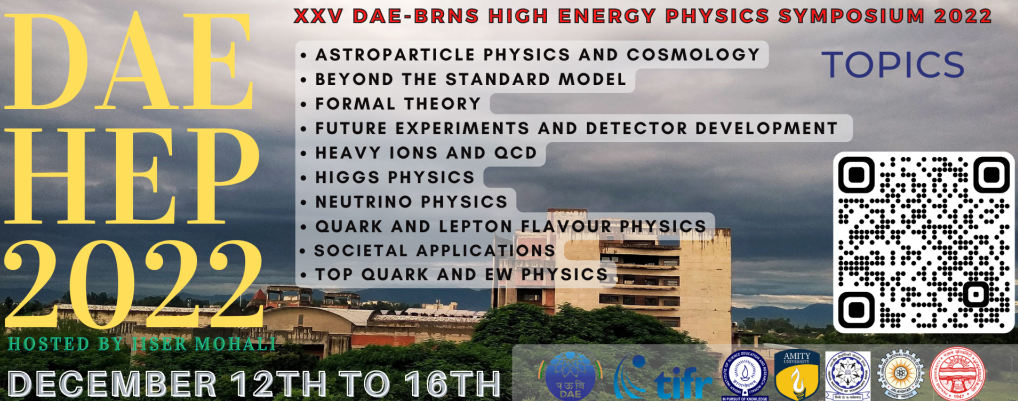Speaker
Description
In standard model of electroweak interaction, neutrino charge in vacuum vanishes and this follows from the requirement of anomaly cancelation $(SU(2)_{L} \times U(1)_{Y})$.
In a thermal medium in presence of an external electro-magnetic field,
neutrino can interact with photon, mediated by the corresponding charged
leptons (real or virtual). Thus it acquires an effective charge. In this theory, this comes from the vector type and axial vector type vertex of
weak interaction. In absence of magnetic field only the vector type vertex contributes\cite{pal1,orae}. On the other hand in a magnetized plasma, the
axial vector part also start contributing to the effective charge
of neutrino. This contribution is dominant to order $\frac{eB}{m_{e}^2}$ for $eB < m_{e}^2$,
when $B$ is the magnetic field. The size of the contribution is: $
e^{\nu_{a}}_{eff} \sim -(3.036 \times 10^{-12})\left[g_{A}e\left(\frac{{ B}}{B_{c}}\right) \frac{1}{\pi^{3/2}}\right] \left(\sqrt{\frac{m_{e}}{T}} \right)
e^{-m_{e}/T}\cosh(\mu/T)(1-\lambda)\cos\theta.$
In this equation, for electron neutrinos, $g_{\rm A} = (-1 + 1/2)$ and for mu and tau neutrinos
$g_{\rm A} = (1 - 1/2)$, $B_{c} \sim \frac{m_{e}^{2}}{e}$, $m_{e}$ is the electron mass, $e$ is electron charge, $T$ is temperature, $\mu$ is the chemical potential, $\lambda$ happens to be the helicity of the (Dirac type) neutrino and $\theta$ is the angle between the neutrino momentum and the magnetic field.
In an earlier paper we had obtained this result \cite{MDPI}. \
\indent
In this paper we estimate the contribution
to neutrino effective charge from the vector type (coupling constant $g_{V}$) vertex $e^{\nu_{V}}_{eff}$ coming from the polarization tensor $\Pi_{\mu\nu}$ in a magnetized medium. For electron type neutrinos $g_{\rm V} = 1 - (1 - 4 \sin^2 \theta_{\rm W})/2$,
and for tau and mu type neutrino $g_{\rm V} = -(1 - 4 \sin^2 \theta_{\rm W})/2 $. \
\indent
We note that keeping PCT symmetry in view, the leading powers of $B$ and $\mu$
that appears in the expression of $e^{\nu_{V}}_{eff}$ is of order $(eB)^{2}$ and $\mu^{2}$. We further elucidate on the direction dependence of this charge thats a manifestation of loss of isotropy due to the presence of an external field. The expression of the induced charge from the vector type vertex happen to be:
\begin{eqnarray}
e^{\nu_{V}}{eff} &=& \frac{G{F}g_{V}}{\sqrt{2}e} \left(\frac{e^{2} m_{e}^{2}}{ 1.68\pi^{\frac{3}{2}}} e^{-\frac{\sqrt{2}m_{e}}{T}}{\cal F}(\theta)\right)
\left(1- \frac{\lambda|k|}{\omega}\right)\left[\left(\frac{T}{m_{e}}\right)^{\frac{1}{2}} + \left(\frac{m_{e}}{T}\right)^{\frac{3}{2}} \left(\frac{eB}{m_{e}^{2}}\right)^{2}\right].
\end{eqnarray}
In the ultra-relativistic limit the neutrinos with $\lambda = -1$ acquire the charge, the other helicity state remains charge neutral. We conclude this work by inferring on astrophysical and cosmological consequences of the same.
\begin{thebibliography}{999}
\bibitem{pal1} J.~F. Nieves and P.~B. Pal, Phys. Rev. D {\bf 49}, 1398 (1994),
%J.~C. D'Olivo, J.~F. Nieves and P.~B. Pal, Phys. Rev. D {\bf
%40}, 3679 (1989),
R.~N. Mohapatra and ~P.~B.~Pal. {\em Massive
neutrinos in Physics
and Astrophysics}, (World Scientific, 2nd Ed. 1998.)
\bibitem{orae} V.~N. Oraevsky, V.~B. Semikoz and Ya.~A. Smorodinsky, JETP Lett. {\bf 43}, 709 (1986)
%\bi{pal2} J.~F. Nieves and P.~B. Pal, Phys. Rev. D {\bf 49}, 1398 (1994)
\bibitem{MDPI} Avijit K. Ganguly, Venktesh Singh, Damini Singh, Ankur Chaubey, MDPI {\it Galaxies} {\bf 9}, 2 (2021).
\end{thebibliography}
| Session | Astroparticle Physics and Cosmology |
|---|
